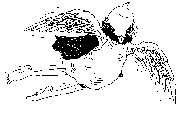Cheerful and gentle anarchy
Joke van Leeuwen’s work also contains all the ingredients necessary for a successful children’s book. Cheerful and gentle anarchy is the main theme. In a perfect combination of illustrations and text and with disarming humour and amazing skill with language, she creates intriguing characters who observe the world. In 1978 her first book appeared, De Appelmoesstraat is anders (Applesauce Street Is Different), an extremely nonconformist - for the time - book illustrated in black-and-white about a newcomer who wants to end the uniformity of her new street. Humour and a cabaret-like gaiety have always been important elements of her work; abuse and distress are not ignored, but are implicitly present without being emphasised. In her second book, Een huis met zeven kamers (A House with Seven Rooms, 1979), a girl explores the house of her jolly uncle. A funny story is associated with each room. Between the stories there are songs, rhymes, puzzles and handwritten letters to read. The book is also richly illustrated with curious pen-and-ink drawings which playfully supplement the text. With each book the author has developed her enormous talent with language: puns, telling names for people and things, and inimitable dialogues form her trademark.
In almost every book by Joke van Leeuwen, the heroes carry out a search, follow a quest. The characters are always on their way somewhere, towards a safe haven for themselves. The children she sketches are, despite their childlike naivety, surprisingly emancipated and stubborn; the adults generally appear less heroic.

Illustration by Joke van Leeuwen
In Deesje (1985) a rather unworldly girl is sent by her father to live with her ‘half-aunt’ in the city. Naturally, it becomes a spark ling journey full of entanglements and peculiar meetings. The same theme can be found in Het verhaal van Bobbel die rijk wilde worden en in een bakfiets wilde wonen (The Story of Bobble Who Wanted to be Rich, 1987). Here, too, the unconventional heroine has difficulty fitting into regulated society. De wereld is krom maar mijn tanden staan recht (The World Is Crooked But My Teeth Are Straight, 1995) is a type of comic book or cartoon story about ‘the lighter and darker sides of the beginning of a woman’s life’. The beginning of that life is unfolded in a perfect combination of text and illustration with dazzling but often cutting humour. A book which will ring a bell with every adolescent girl.
Iep! (1996) appears initially to be just a funny story, but is actually much more. It is a moving book about lack and loss, about the desire for freedom and emancipation, about loneliness and alienation. The small female bird Viegeltje gives a new slant on reality to everyone she meets - the world as seen and experienced from the air. The dominant tone is one of lightness: witty puns, subtle and mild observations of la comedie humaine of the adult world, boundless imagination and disarming illustrations. Iep! is a combination of all that is best about Joke van Leeuwen’s writing. The book repeat edly won prizes in 1997. Through the versatility of her talents, she succeeds in captivating and appealing to readers of all ages. For Flanders and the Netherlands, Joke van Leeuwen is a worthy successor to the grand old lady Annie M.G. Schmidt.
Search Website
Essays (English)
- Judges' Report. Vondel Translation Prize 2009 Paul Binding, Susan Massotty, Ina Rilke
- Character. On Character by F. Bordewijk By Cees Nooteboom
- Dark Poetry and Ambiguity. On the The Darkroom of Damocles by W.F. Hermans By Milan Kundera
- Waiting for a Pioneer. The Development of the Dutch Thriller By Gijs Korevaar
- Young poets, packed houses. Dutch poetry from the eighties to the present By Tatjana Daan
- Beauty and Truth neighbours once more. Literary Non-Fiction in the Netherlands and Flanders By Ger Groot
- God's Fingerprint. Modern Dutch Prose By Onno Blom
- A Quilt of Many Colours. Contemporary Children's Books By Annemie Leysen
- Between the Individual and Society. Postwar Prose in Holland and Flanders By Jaap Goedegebuure
- There Is No Such Thing as Dutch Literature. Dutch Literature Seen From Abroad By Hermann Wallmann
- A Walk on the Wild Square. Poetry of the 1980s and 1990s By Paul Demets
Essays (Nederlandstalig)
- Homeros bijna nabij? Een Iliasvertaling door Patrick Lateur
- Verzoening met het eigen werk door Anneke Brassinga
- 'The Windhover' van Gerard Manley Hopkins door Maarten Elzinga en Koen Stassijns
- 'Stamboom' van Rozalie Hirs
- Over het vertalen van De Danser van Nijhoff door David Colmer
- 'Verhuizen' van Peter Theunynck door Ira Wilhelm en Ard Posthuma
- Ontroerd door afstand door David Colmer
- Juryrapport. Phares du Nord Prijs 2009 door Danielle Bourgois, Margot Dijkgraaf, Annie Kroon
- Dankwoord Anita Concas door Anita Concas
- De vondsten van een kinderboekvertaler door Rolf Erdorf
- Serendipity. Of de betrekkelijkheid van vondsten door Barber van de Pol
- Het huiswerk van de taalman door Pjeroo Roobjee
- Een staat van genade. Vertaalvondsten door Peter Verstegen
- Op de Berlagebrug. Over het vertalen van liedteksten door Jan Boerstoel
